|
Printables |
PowerPoints |
Online exercises |
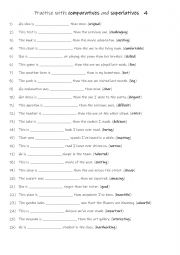
|
A1+-A2 Practise with comparatives and superlatives 4
Students read the sentence and complete the sentence with the correct form of the given adjective in (). Each form is used 13 times! Answers on page 2.
Level: elementary
Age: 7-100
Type:
Downloads: 113
|
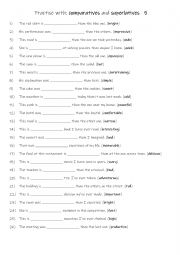
|
A1+-A2 Practise with comparatives and superlatives 5
Students read the sentence and complete the sentence with the correct form of the given adjective in (). Each form is used 13 times! Answers on page 2.
Level: elementary
Age: 8-100
Type:
Downloads: 119
|
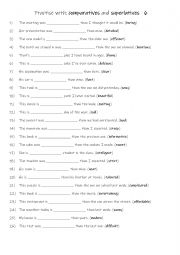
|
A1+-A2 Practise with comparatives and superlatives 6
Students read the sentence and complete the sentence with the correct form of the given adjective in (). Each form is used 13 times! Answers on page 2.
Level: elementary
Age: 8-100
Type:
Downloads: 108
|
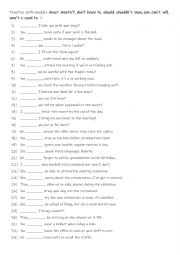
|
A1+-A2 Practise with modals must, mustn�t, don�t have to, should, shouldn�t, may, can, can�t, will, won�t & used to 1
Practising modals like must, should, can, and used to is essential for students as it enhances their ability to express necessity, advice, permission, and past habits. This not only improves their grammar and sentence construction but also builds confidence in real-life communication, whether giving instructions, making requests, or discussing poss...
Level: elementary
Age: 9-100
Type:
Downloads: 102
|
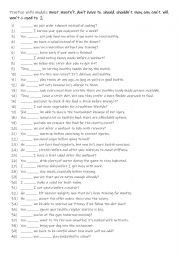
|
A1+-A2 Practise with modals must, mustn�t, don�t have to, should, shouldn�t, may, can, can�t, will, won�t & used to 2
First, students need to familiarise themselves with the modals and their use. Then they read the sentences to see which one is needed to complete the sentence. Answers on page 2.
Level: elementary
Age: 8-100
Type:
Downloads: 115
|
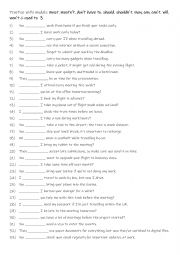
|
A1+-A2 Practise with modals must, mustn�t, don�t have to, should, shouldn�t, may, can, can�t, will, won�t & used to 3
First, students need to familiarise themselves with the modals and their use. Then they read the sentences to see which one is needed to complete the sentence. Answers on page 2.
Level: elementary
Age: 8-100
Type:
Downloads: 107
|
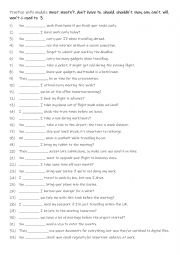
|
A1+-A2 Practise with modals must, mustn�t, don�t have to, should, shouldn�t, may, can, can�t, will, won�t & used to 3
Practising modals like must, should, can, and used to is essential for students as it enhances their ability to express necessity, advice, permission, and past habits. This not only improves their grammar and sentence construction but also builds confidence in real-life communication, whether giving instructions, making requests, or discussing poss...
Level: elementary
Age: 9-100
Type:
Downloads: 113
|
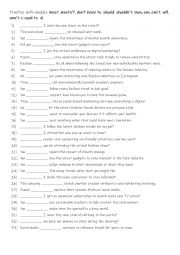
|
A1+-A2 Practise with modals must, mustn�t, don�t have to, should, shouldn�t, may, can, can�t, will, won�t & used to 4
First, students need to familiarise themselves with the modals and their use. Then they read the sentences to see which one is needed to complete the sentence. Answers on page 2.
Level: elementary
Age: 8-100
Type:
Downloads: 123
|
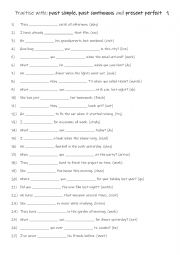
|
A1+-A2 Practise with past simple, past continuous and present perfect 1
Students at the A1+ to A2 level should practise the past simple, past continuous, and present perfect tenses to establish a solid grammar foundation. This helps them describe past events, ongoing actions, and experiences up to the present. Mastering these tenses improves fluency, enabling students to speak more naturally and engage in everyday conv...
Level: elementary
Age: 8-100
Type:
Downloads: 112
|
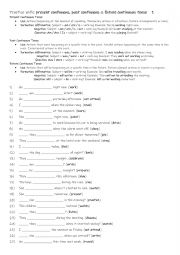
|
A1+-A2 Practise with present continuous, past continuous & future continuous tense 1
Learning the Present Continuous, Past Continuous, and Future Continuous tenses is crucial for effective communication, as they allow students to describe ongoing actions, provide context to events, and discuss future plans. These tenses help express temporary actions, describe interruptions, and improve storytelling by adding detail and specificity...
Level: elementary
Age: 8-100
Type:
Downloads: 114
|
|
|
|
|












